- The Promise of Mobile DTV, NAB Broadcast Engineering Conference Proceedings, 2011.
- A Revenue Model for Mobile DTV Service, NAB Broadcast Engineering Conference Proceedings, 2010.
- Considerations for Digital Program Insertion of Multiple-Video Programs, NCTA Fall Technical Forum, 2002.
- Digital Video and the National Information Infrastructure, Philips Journal of Research, Volume 50, Issues 1–2, 1996.
- MPEG-2 video decoder for the digital HDTV Grand Alliance system, IEEE Transactions on Consumer Electronics, Vol. 41, Aug 1995.
- Grand Alliance MPEG-2-based video decoder with parallel processing architecture, Intl. J. of Imaging Systems and Technology Vol. 5, No. 4, 1994.
- The ISO/MPEG Audio Coding Standard, Widescreen Review, June/July, 1994.
Category: Broadcasting
NAB 2019 Conference Widely Featuring ATSC 3.0
More than 100 NAB Show sessions and more than 50 exhibitors will feature Next Gen TV technology that is now voluntarily spreading to cities throughout the country. Powered by the ATSC 3.0 next-generation broadcast standard, Next Gen TV promises to deliver sharper, more detailed pictures and lifelike multichannel audio with upgraded broadcasts that will be transmitted and received in the same Internet Protocol language as Internet-delivered content.
Jointly sponsored by the Advanced Television Systems Committee, the Consumer Technology Association and NAB, the “Ride the Road to ATSC 3.0” exhibit will be featuring a series of free presentations about all facets of the ATSC 3.0 standard. And attendees can pick up a free Guide to 3.0 at the Show in the Central Lobby of the Las Vegas Convention Center during the show.
Single Frequency Network Demonstrations
The NAB, with support from a number of technology companies, will demonstrate the Single Frequency Network (SFN) capabilities of the Next-Gen TV standard, showing how reception can be improved in difficult locations and in moving vehicles by deploying multiple broadcast towers transmitting the broadcast signal on the same channel.
Using several local transmissions, special SFN viewing kiosks will showcase the flexibility of the ATSC 3.0 standard. Dozens of sessions planned in the exhibit will include updates on the Dallas, Phoenix, Santa Barbara, East Lansing, Cleveland, and Korea ATSC 3.0 deployments.
Scores of papers and sessions will be presented about Next-Gen TV during the 2019 NAB Show, with session topics that will cover consumer research, consumer device plans, conformance testing, audio enhancements, station build-out advice, watermarking, advanced emergency information, channel security, advanced advertising
AGC Systems president Aldo Cugnini will be at the show, and available for discussions regarding support for ATSC and other related ventures. If you’d like to meet up, please contact us.
FCC Opens Up Spectrum Above 95 GHz
This month, the Federal Communications Commission allowed a plan to make the spectrum above 95 GHz more readily accessible for new innovative services and technologies. Calling the initiative “Spectrum Horizons Experimental Radio Licenses,” the plan is outlined in a First Report and Order, which allows a number of changes to existing rules, including:
- a new category of experimental licenses, to increase opportunities for entities to develop new services and technologies from 95 GHz to 3 THz, with no limits on geography or technology; and
- making 15.2 gigahertz of spectrum available for unlicensed use.
The Order specifically allows two types of operations:
- A Spectrum Horizons experimental radio license can be issued for the purpose of testing and marketing devices on frequencies above 95 GHz, where there are no existing service rules. Licenses are issued for a term of 10 years and may not be renewed.
- Unlicensed operations are allowed in the bands 116-123 GHz, 174.8-182 GHz, 185-190 GHz, and 244-246 GHz, that are consistent with the rules proposed in the Spectrum Horizons, Notice of Proposed Rulemaking and Order.
Part 15 of the FCC Rules was also amended to extend operational limitations and interference measurements covering frequencies above 95 GHz.
The new rules provide that the Commission may, at any time without notice or hearing, modify or cancel a Spectrum Horizons License, if, in its discretion, the need for such action arises. Some commenters raised the issue that this could result in an abuse of the complaint process, but the Commission pushed back, saying they “routinely work with parties to resolve potential or actual issues…”
The Commission withheld action on their proposal for licensed fixed point-to-point operations in a total of 102.2 gigahertz of spectrum, and opposed the concerns of the ham-radio organization ARRL regarding protection from interference. In defending the latter position, the Commission states, “both the amateur radio service and the experimental licensing program are designed to contribute to the advancement of radio knowledge,” and goes on to say that “we will instead require all Spectrum Horizons License applicants to submit an interference analysis that would address the potential effects of the experimental operation on existing services.”
In addition to Chairman Ajit Pai, the proposal has general support — albeit with certain cautions — from all four of the other commissioners, who evenly represent both sides of the political aisle.
— agc
ATSC 3.0 Announcements at CES 2019

With the ATSC 3.0 standard essentially finished last year, the casual observer might have expected to see new product at this year’s CES Show in Las Vegas.
Indeed, while there were a few 3.0 TVs scattered about – including at invitation-only showings by well-known TV manufacturers at suites and hotels – they were only early prototypes, since we shouldn’t expect to see real product announcements until the 2020 show – which just happens to be when broadcasters have said they will crank up transmissions using the new standard.
Echoing this at the show was the VP of Communications at LG, John Taylor, who said, “We expect that the launch pad is really 2020,” which is consistent with the typical 18 to 24 month silicon design cycle for chips to follow a new standard.
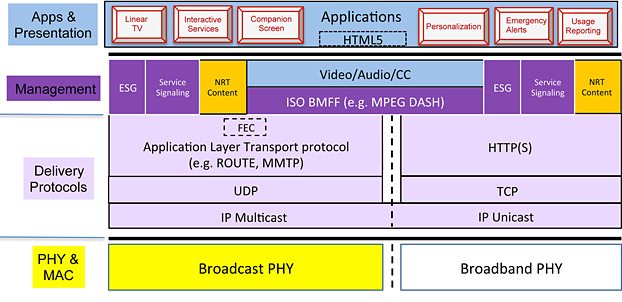
ATSC 3.0 is, of course, the latest version of the Advanced Television Systems Committee (ATSC) standard. It will support several advances including mobile viewing, 3D television, 4K Ultra High Definition (UHD), high dynamic range (HDR), high frame rate (HFR), and wide color gamut (WCG) picture quality, as well as immersive audio and interactivity.
Until we see those new products emerge, the news we’re more likely to see will be from broadcasters.
Industry Leaders Collaborate to Launch ATSC 3.0 Chip for Broadcast and Mobile Applications
ONE Media LLC, a subsidiary of Sinclair Broadcast Group, and India’s Saankhya Labs, together with VeriSilicon and Samsung Foundry, announced at CES the successful launch of an advanced multi-standard demodulator System-on-a-Chip (SoC) supporting the ATSC 3.0 standard.
![]()
The universal demodulator chip is based on Saankhya’s patented Software Defined Radio Platform, and supports 12 DTV standards including ATSC 3.0, DVB-T2, ISDB-T, and satellite and cable standards for TV, set-top boxes, and home gateways, as well for automotive and mobile applications.
This announcement follows Sinclair Broadcast Group’s recent commitment to a nationwide roll-out of ATSC 3.0 service and its past announcement to fund millions of chipset giveaways for wireless operators.
Two variants of the chip were announced: a “Demod-only” variant, SL3000, is designed for TV applications such as in HDTV sets, Set-top Boxes (STB) and home gateways. A “Demod-plus” Tuner variant, SL4000, is designed for mobile and portable devices, possibly making it the world’s first mobile-ready ATSC 3.0 chip. The mobile device is targeted to accelerate the adoption of the ATSC 3.0 standard across markets with both Direct-To-Mobile TV capabilities and Broadcast/Broadband convergence solutions.
The demodulator SoC was designed and developed by Saankhya Labs with ASIC turnkey design and manufacturing services from VeriSilicon, using Samsung Foundry’s state-of-the-art 28FDS (Fully Depleted SOI) process technology), chosen for its low-power capabilities.
Mark Aitken, President of ONE Media 3.0, said,
These mobile 3.0 chips validate the ‘sea change’ in over-the-air distribution of not only television, but all digital data. Broadcasters are doing their part by deploying the NextGen transmission facilities, and now there will be devices enabled to receive that data, personalized and in mobile form. This chip is the key to that disruptive future in a 5G world.”
Broadcasters and Mobile Operators Partner to Deploy ATSC 3.0 – Harman Separately Partnering in Mobile Applications
SK Telecom and Sinclair Broadcast Group announced in Las Vegas that the companies signed a joint venture agreement to lead next-generation broadcasting solutions market in the U.S. and globally. The two companies will jointly fund and manage a joint venture company within the first quarter of this year. The joint venture company will develop innovative broadcasting solutions based on ATSC 3.0.
The commercialization of broadcasting solutions based on ATSC 3.0 – which enables data communications in broadcasting bands – will give rise to new services such as personalized advertisement and in-vehicle terrestrial TV broadcasting and map updates. It will also support two-way communication between broadcasting companies and user’s smartphone/vehicle/TV by recognizing user’s personal IP address.
SK Telecom and Sinclair anticipate all television broadcasting stations throughout the U.S. will adopt broadcasting solutions based on ATSC 3.0 within the next decade. Through the joint venture company, the two companies plan to actively provide ATSC 3.0 standards-based solutions to all U.S. broadcasting companies and seek other opportunities globally. The joint venture agreement follows last year’s memorandum of understanding (MOU) signed between SK Telecom and Sinclair at CES 2018 to jointly develop leading technology for ATSC 3.0 broadcasting.
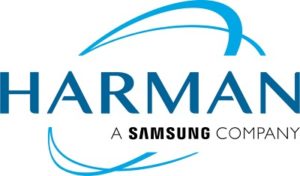 Separately, the two companies also announced at the 2019 CES Show that they signed a Memorandum of Understanding (MoU) with Harman International, a subsidiary of Samsung, to jointly develop and commercialize digital broadcasting network-based automotive electronics technology for global markets.
Separately, the two companies also announced at the 2019 CES Show that they signed a Memorandum of Understanding (MoU) with Harman International, a subsidiary of Samsung, to jointly develop and commercialize digital broadcasting network-based automotive electronics technology for global markets.
The companies intend to unveil their automotive platform and related equipment and services for the first time at the 2019 National Association of Broadcasters Show (NAB Show) in Las Vegas in April 2019.
— agc
ATSC 3.0 Featured Prominently at 2018 NAB Conference
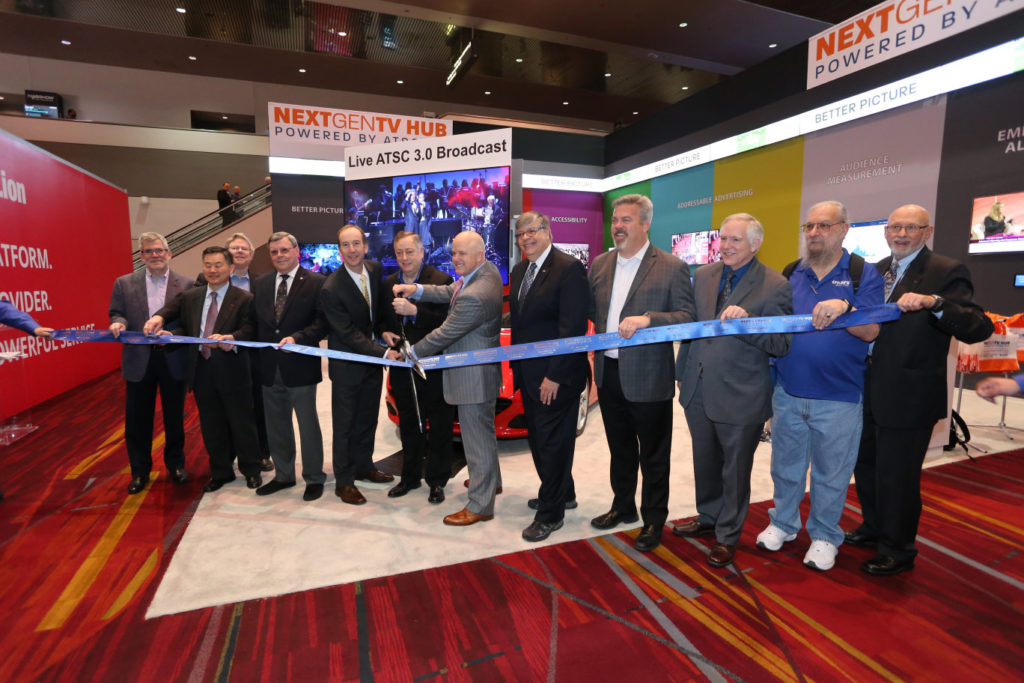
“The Road to ATSC 3.0: Powered by ATSC 3.0” Ribbon Cutting CeremonyDeployment of ATSC 3.0 is off and running, with a strong showing this month at this year’s NAB Conference in Las Vegas. More than 40 exhibitors and 22 technology-and-business sessions demonstrated the level of interest in the new Next Generation Broadcast TV standard, with a ribbon-cutting ceremony kicking off the activities.
ATSC President Mark Richer underscored the level of 3.0 presence at the show, saying “That’s how we know it’s real, and that’s how we know it’s happening,” and Sam Metheny, EVP/CTO at NAB, said that while ATSC is now “moving to the implementation phase,” it is a “living standard that will continue to evolve over time.” Mike Bergman, Senior Director, Technology & Standards at the Consumer Technology Association, anticipates “broad deployment, and a breathtakingly immersive viewing experience,” which should complement the growing momentum of 4K TV sales.
Now that the ATSC 3.0 standard has been approved, broadcasters can develop two-way, IP-based connections with their viewers and deliver TV experiences on par with other digital media. Looking to the future, conference panelists addressed key Next Gen TV capabilities, including enhanced audience insights, addressable advertising, interactivity, and personalization, along with plans to generate incremental revenue and audience engagement.
Broadcasters are used to slow change, but now need to change faster, even on a monthly basis. The world is changing faster, and consumer demands are changing, with OTA viewership growing, and OTT services and usage growing. Mobile viewing continues to increase, a cord cutting / shaving / nevers are changing TV marketplace dynamics. On-demand viewing is an assumed feature, and digital advertising is increasingly powerful, so targeted advertising is now essential.
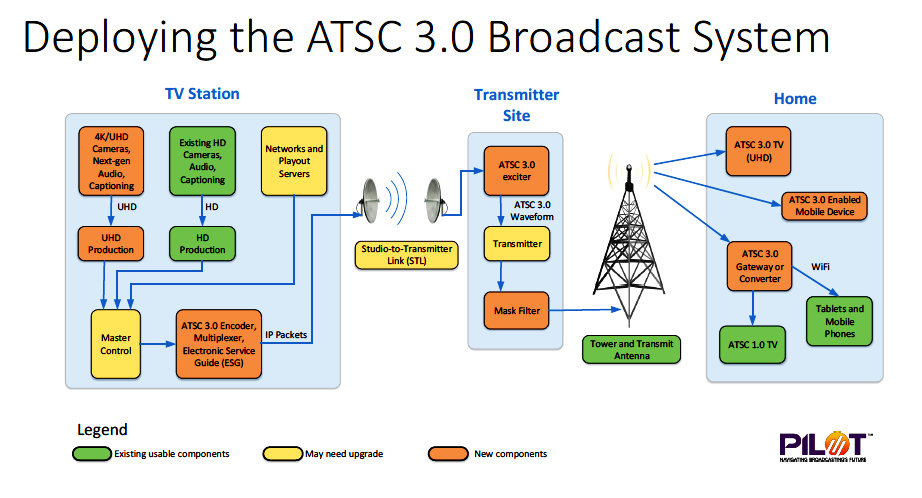
SFNs (single-frequency networks, a broadcast technology comparable to mobile cellular networks) will enable all of these new services, and data analytics will drive the opportunities. The WiFi/mobile broadband return channel defined by ATSC 3.0 means that even simple receivers need a back channel.
While MVPDs (Multichannel video programming distributors, i.e. cable and satellite) have long provided a revenue stream to broadcasters through retransmission-consent agreements, this could be one key area of the change in business model made possible by ATSC 3.0, which is not mandated by the FCC, other than at the transmission layer, and whose carriage is not currently subject to retrans obligations.
Broadcasters are interested in gathering viewership data from mobile devices and doing dynamic ad insertion. Reaching individuals will be attractive to advertisers, and broadcasters can now put movies into home boxes for Netflix, bypassing MVPDs. ATSC 3.0 is thus poised as a medium to test new business models, and broadcasters can partner with other spectrum owners and mobile carriers to supplement the “traditional” mobile spectrum.

The Phoenix Model Market project is the first collaborative single-market effort to plan for and implement a transition to next-generation over-the-air television broadcasting. Twelve stations in the Phoenix market are participating, with service testing expected to start Q2’18, and consumer service testing in Q4’18. In addition to business model testing, consumer testing will extend into 2019.
Among the consumer-facing business models to be tested are program guide & hybrid TV, personalization, and emergency alerts. On the broadcaster side, content protection, data & measurement, advanced advertising, and transition models will be evaluated.
— agc
Next Generation Broadcast TV
AGC Systems has advised and worked with clients to influence, develop, and realize the technologies that form the basis of Next Generation Broadcast Television (NGBT), including the ATSC 3.0 Broadcast Standards. Starting with the original ATSC Planning Teams, and progressing to the latest developments, we have participated closely in the development of:
- ATSC Final Report on NGBT
- ATSC Video coding
- ATSC Audio coding
- ATSC Physical Layer
As a result of our advisory services, our clients have achieved their short- and long-term objectives for new business development.
More about …
Prior to his DTV work, Aldo developed various audio, content delivery and broadcast technologies at CBS Laboratories. He was also Chief Engineer at WKCR-FM and a broadcast engineer at WABC and WPLJ, all in New York City. 
Aldo received his BS and MS degrees from Columbia University, is an inventor on fourteen issued patents (eight as an entrepreneur) in the fields of digital television, audio, broadcasting and spectrum management, and has served on the Board of Directors of the Advanced Television Technology Center.
A speaker at various industry conferences, he is the author of numerous technical papers and industry reports, including chapters in the 10th and 11th editions of the NAB Engineering Handbook, and has been a regular contributor to several trade publications.
A joint recipient of a 1997 Engineering Emmy® statuette and R&D Magazine’s 1998 R&D 100 Award (both on behalf of Philips), Aldo is listed in Who’s Who in America, and is an inductee of the Academy of Digital Television Pioneers. He is a Senior Member of IEEE, with memberships in its Broadcast Technology Society and Society on Social Implications of Technology.
An active member of the Advanced Television Systems Committee (ATSC), Aldo actively participates in ITU-R Study Group 6 Working Party 6A (WP 6A) – Terrestrial broadcasting delivery and Working Party 6B (WP 6B) – Broadcast service assembly and access, and co-chairs the WP6A Rapporteur Group on Revision of ITU-R Texts To Include ATSC 3.0. He has also been a member of the American Association for the Advancement of Science (AAAS), the Audio Engineering Society (AES), and the Consultants’ Network of Northern New Jersey (CNNNJ). In academia, Aldo has served as Adjunct Professor of Engineering Technology and Engineering Science at the County College of Morris in New Jersey.
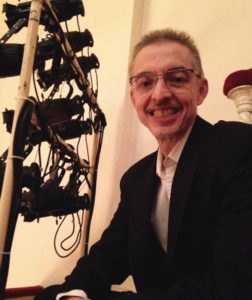 Aldo holds FCC Commercial General (formerly First Class) Radiotelephone and Amateur General Radiotelephone (W2AGC) Operator’s licenses. He is an inductee of the Eta Kappa Nu honor society, and was a top finalist in the IEEE-USA Congressional Fellowship and New America TechCongress Congressional Innovation Fellowship programs. His volunteer efforts include particpating in the Catchafire initiative, being a mentor and judge with the NSTEP TechXplore program to advance STEM education in America’s classrooms, providing stage lighting design and production for local schools, and as an adjunct musician for various youth and non-profit orchestras.
Aldo holds FCC Commercial General (formerly First Class) Radiotelephone and Amateur General Radiotelephone (W2AGC) Operator’s licenses. He is an inductee of the Eta Kappa Nu honor society, and was a top finalist in the IEEE-USA Congressional Fellowship and New America TechCongress Congressional Innovation Fellowship programs. His volunteer efforts include particpating in the Catchafire initiative, being a mentor and judge with the NSTEP TechXplore program to advance STEM education in America’s classrooms, providing stage lighting design and production for local schools, and as an adjunct musician for various youth and non-profit orchestras.
In his spare time, Aldo has been an avid timpanist with the Hanover Wind Symphony and the South Orange Symphony Orchestra, and now performs with Spires Brass Band and other groups in Frederick, Maryland. As a semi-professional musician, he has performed music by composers ranging from Beethoven and Mahler to Leonard Bernstein and Philip Glass, in venues that have included Carnegie Hall and the Mayo Performing Arts Center in Morristown, New Jersey. His other interests include astronomy, radio-controlled helicopters, ham radio, and writing for Wikipedia and the occasional blog. He maintains memberships in the American Radio Relay League (ARRL) and the Academy of Model Aeronautics (AMA).
A Rich Heritage — and a Debt of Gratitude
Aldo Cugnini has worked with and studied under several widely-respected authorities in their fields. He has benefited greatly from having known them and others:
- Renville H. McMann: FM, video, transmission
- Emil L. Torick: audio, musical instrument technology
- Jim Turner: electronic musical instruments
- Carlo Basile: video
- Jacob Millman: electronics
- Cyril M. Harris: sound, acoustics
… and with Further Gratitude to his Longtime ATSC Colleagues
- Mark Aitken
- Lynn Claudy
- Mark Corl
- Luke Fay
- Jerry Fritz
- Adam Goldberg
- Paul Hearty
- Walt Husak
- Louis Libin
- Madeleine Noland
- Sung-Ik Park
- Skip Pizzi
- Glenn Reitmeier
- Mark Richer
- Jim Starzynski
- Alan Stein
- Joop Talstra
- Craig Tanner
- Merrill Weiss
- Jerry Whitaker
<back>
There’s No Such Thing as RMS Power!
This is one of my engineering pet peeves — I keep running into students and (false) advertisements that describe a power output in “RMS watts.” The fact is, such a construct, while mathematically possible, has no meaning or relevance in engineering. Power is measured in watts, and while the concepts of average and peak watts are tenable, “RMS power” is a fallacy. Here’s why.
The power dissipated by a resistive load is equal to the square of the voltage across the load, divided by the resistance of the load. Mathematically, this is expressed as [Eq.1]:
\large P=\frac{V^{2}}{R}
where P is the power in watts, V is the voltage in volts, and R is the resistance in ohms. When we have a DC signal, calculating the power in the load is straightforward. The complication arises when we have a time-varying signal, such as an alternating current (AC), e.g, an audio signal or an RF signal. In the case of power, the most elementary time-varying function involved is the sine function.
When measuring the power dissipated in a load carrying an AC signal, we have different ways of measuring that power. One is the instantaneous or time-varying power, which is Equation 1 applied all along the sinusoid as a time-varying function. (We will take R = 1 here, as a way of simplifying the discussion; in practice, we would use an appropriate value, e.g., 50Ω in the case of an RF load.)
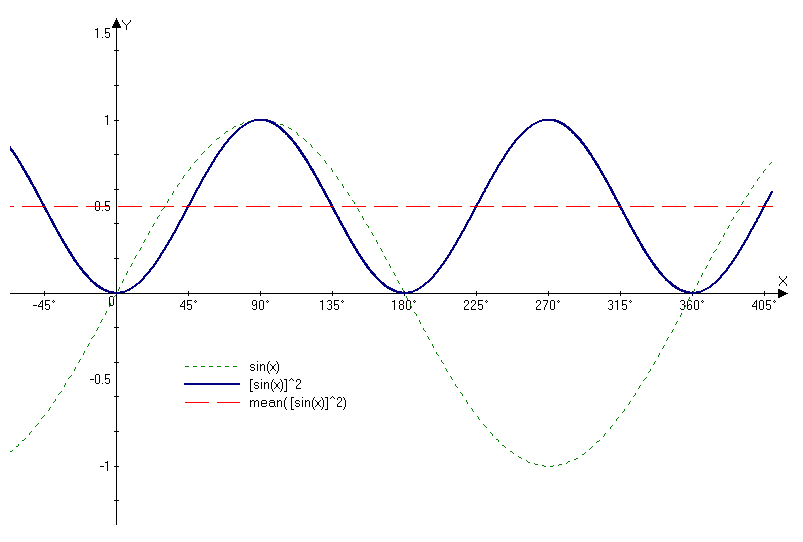
In Figure 1, the dotted line (green) trace is our 1-volt (peak) sinusoid. (The horizontal axis is in degrees.) The square of this function (the power as a function of time) is the dark blue trace, which is essentially a “raised cosine” function. Since the square is always a positive number, we see that the instantaneous power as a function of time rises and falls as a sinusoid, at twice the frequency of the original voltage. This function itself has relatively little use in most applications.
Another quantity is the peak power, which is simply Equation 1 above, where V is taken to be the peak value of the sinusoid, in this case, 1. This is also known as peak instantaneous power (not to be confused with peak envelope power, or PEP). The peak instantaneous power is useful to understand certain limitations of electronic devices, and is expressed as follows:
\large P_{pk}=\frac{V^{2}_{pk}}{R}
A more useful quantity is the average power, which will provide the equivalent heating factor in a resistive device. This is calculated by taking the mean (i.e., the average) of the square of the voltage signal, divided by the resistance. Since the sinusoidal power function is symmetric about its vertical midpoint, simple inspection (see Figure 1 again) tells us that the mean value is equal to one-half of the peak power [Eq.2]:
\large P_{avg}=\frac{P_{pk}}{2}=\frac{V^{2}_{pk}/R}{2}
which in this case is equal to 0.5. We can see this in Figure 1, where the average of the blue trace is the dashed red trace. Thus, our example of a one-volt-peak sinusoid across a one-ohm resistor will result in an average power of 0.5 watts.
Now the concept of “RMS” comes in, which stands for “root-mean-square,” i.e., the square-root of the mean of the square of a function. The purpose of RMS is to present a particular statistical property of that function. In our case, we want to associate a “constant” value with a time-varying function, one that provides a way of describing the “DC-equivalent heating factor” of a sinusoidal signal.
Taking the square-root of V2pk/2 therefore provides us with the root-mean-square voltage (not power) across the resistor; in this example, that means that the 1-volt (peak) sinusoid has an RMS voltage of
\large V_{rms}=\sqrt{\frac{V^{2}_{pk}}{2}}=\frac{V_{pk}}{\sqrt{2}}\approx 0.7071
Thus, if we applied a DC voltage of 0.7071 volts across a 1Ω resistor, it would consume the same power (i.e., dissipate the same heat) as an AC voltage of 1 volt peak (0.7071 volts RMS). (Note that the RMS voltage does not depend on the value of the resistance, it is simply related to the peak voltage of the sinusoidal signal.) Plugging this back into Eq. 2 then gives us:
\large P_{avg}=\frac{V^{2}_{rms}}{R}
Note the RMS voltage is used to calculate the average power. As a rule, then, we can calculate the RMS voltage of a sinusoid this way:
\large V_{rms} \approx 0.7071 \cdot V_{pk}
Graphically, we can see this in Figure 2:
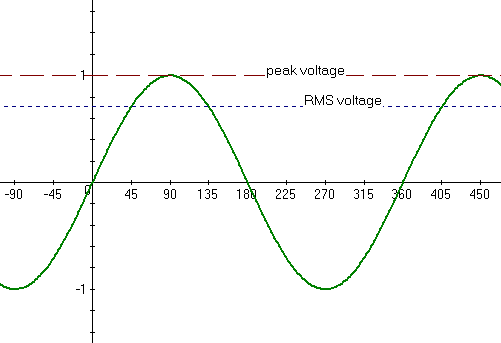
The astute observer will note that 0.7071 is the value of sin 45° to four places. This is not a coincidence, but we leave it to the reader to figure out why. Note that for more complex signals, the 0.7071 factor no longer holds. A triangle wave, for example, yields Vrms ≈ 0.5774 · Vpk , where 0.5774 is the value of tan 30° to four places.
For those familiar with calculus, the root-mean-square of an arbitrary function f(t) is defined as:
\large F_{rms} = \sqrt{\frac{1}{T_{2}-T_{1}}\int_{T_{1}}^{T_{2}}[f(t)]^{2}\, dt}
Replacing f(t) with sin(t) (or an appropriate function for a triangle wave) will produce the numerical results we derived above.
For more information on the root-mean-square concept, see the Wikipedia articles Root mean square and Audio power.
Additional thoughts on root-mean-square
Because of the squaring function, one may get the sense that RMS is only relevant for functions that go positive and negative, but this is not true.
RMS can be applied to any set of distributed values, including only-positive ones. Take, for example, the RMS of a rectified (i.e., the absolute value of a) sine wave. As before, Vrms=0.7071 · Vpk , i.e., the RMS is the same as for the full-wave case. However, Vavg ≈ 0.6366 · Vpk for the rectified wave (but equals zero for the full-wave, of course, and 0.6366 is the value of 2/π to four places). So, we can take the RMS of a positive-only function, and it can be different than the average of that function.
The general purpose of the RMS function is to calculate a statistical property of a set of data (such as a time-varying signal). So the application is not just to positive-going data, but to any data that varies over the set.
—agc
FCC Circulates NPRM to Authorize “Next Generation” Broadcast Television
THE FCC has pre-released a Notice of Proposed Rulemaking (NPRM), supporting the authorization of television broadcasters to use the “Next Generation” broadcast television (Next Gen TV) transmission standard developed by the Advanced Television Systems Committee (“ATSC 3.0”). They support a voluntary, market-driven basis, while broadcasters continue to deliver current-generation digital television (DTV) broadcast service, using the ATSC A/53 standard.
ATSC 3.0 is being developed by broadcasters with the intent of merging the capabilities of over-the-air (OTA) broadcasting with the broadband viewing and information delivery methods of the Internet, using the same 6 MHz channels presently allocated for DTV.
A coalition of broadcast and consumer electronics industry representatives has petitioned the Commission to authorize the use of ATSC 3.0, saying this new standard has the potential to greatly improve broadcast signal reception, particularly on mobile devices and television receivers without outdoor antennas, and that it will enable broadcasters to offer enhanced and innovative new features to consumers, including Ultra High Definition (UHD) picture and immersive audio, more localized programming content, an advanced emergency alert system (EAS) capable of waking up sleeping devices to warn consumers of imminent emergencies, better accessibility options, and interactive services.
With this action, the FCC says its aim is “to facilitate private sector innovation and promote American leadership in the global broadcast industry.” This document has been circulated for tentative consideration by the Commission at its open meeting on February 23. FCC Chairman Ajit Pai has determined that, in the interest of promoting the public’s ability to understand the nature and scope of issues under consideration by the Commission, the public interest would be served by making this document publicly available before officially requesting public comment.
ATSC Developing Conformance Testing Programs to Support Implementation of Next-Gen TV
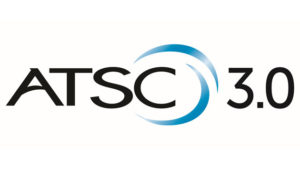
Goal is to Assure Quality Consumer Experience,
Interoperability Between Next-Gen Receivers and Broadcast Content
WASHINGTON, Oct. 10, 2016 – The Advanced Television Systems Committee (ATSC) has issued a Request for Information (RFI) related to the development of Conformance Test Suite Development and Conformity Assessment programs to support the implementation of the ATSC 3.0 next-generation television broadcast standard.
According to ATSC President Mark Richer, the high-level goals of these programs include assuring a quality experience for consumers when viewing and interacting with ATSC 3.0 content, and assuring interoperability between broadcast content and receivers.
“The ATSC expects TV stations to begin testing in earnest in 2017, with early U.S. market deployments in the first half of 2018. To help achieve the highest quality user experience and to assure interoperability, the ATSC and other industry groups have a keen interest in the development of test suites and tools,” Richer said.
The RFI seeks input from industry experts in four areas of testing — Coding, Transmission & Reception; Data & Metadata; and Interactivity; and Security. Specifically, the RFI addresses test suites, test automation, version management, test result formats and administration. The RFI also focuses on program management, including policy and procedure development and third-party assessment plans, as well as implementation tools and experience.
Richer explained that the RFI responses will inform the ATSC and allied organizations as they establish a framework, including initial plans and high-level budgeting, for the conformity assessment program. It is expected the program will eventually be administered under the auspices of one or more industry organizations.
Current planning and technical work for ATSC 3.0 is focused on Internet Protocol-based service delivery and lays the foundation for improved viewing features, such as 4K Ultra HD, targeted advertising, high dynamic range and mobile/portable reception. ATSC 3.0 provides broadcasters the opportunity to deliver an enhanced viewing experience with interactive applications and program guides, including access to pre-cached video for later playback by viewers.
# # #
About the ATSC:
The Advanced Television Systems Committee is defining the future of television with the ATSC 3.0 next-generation broadcast standard. ATSC is an international, non-profit organization developing voluntary standards for digital television. The ATSC’s 140-plus member organizations represent the broadcast, broadcast equipment, motion picture, consumer electronics, computer, cable, satellite, and semiconductor industries. For more information visit www.atsc.org.